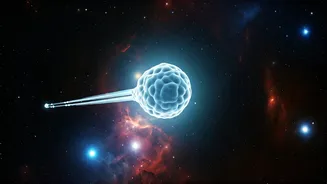Ghostly Subatomic Particles
Neutrinos, often called 'ghost particles,' are fundamental particles with almost no mass and no electrical charge. They interact very weakly with other
matter, allowing them to pass through everything, including the entire Earth, with ease. These interactions are so rare that scientists have to employ enormous detectors in underground labs to observe these nearly invisible particles. The sheer difficulty of detecting them highlights their elusive nature, which makes studying them a significant challenge. However, this weak interaction is also what makes neutrinos useful because they can travel huge distances unaffected by magnetic fields or dense matter, allowing them to carry information from the earliest moments of the universe.
Matter and Antimatter Puzzle
One of the most significant mysteries in cosmology is the matter-antimatter asymmetry. According to the Big Bang theory, equal amounts of matter and antimatter were created, which should have led to mutual annihilation, leaving nothing behind. Yet, the universe is primarily composed of matter. This imbalance points to a violation of charge-parity symmetry, which states that the laws of physics should be the same for matter and antimatter. Scientists are investigating the possibility that neutrinos, due to their unique properties, are the key to this asymmetry. Experiments are focused on exploring neutrino oscillations and other behaviors to see how they might contribute to the dominance of matter.
Neutrino Oscillations Explained
Neutrinos come in three flavors: electron, muon, and tau. One of the most intriguing aspects of neutrinos is that they can change, or 'oscillate,' from one flavor to another. This oscillation implies that neutrinos have mass, a discovery that was awarded the Nobel Prize in Physics. The measurement of neutrino oscillations provides strong evidence that neutrinos have mass, albeit a tiny amount compared to other known particles. Studying these oscillations helps researchers understand how neutrinos behave and how they may have influenced the evolution of the early universe. This is crucial because the processes that created the asymmetry between matter and antimatter would have affected neutrinos differently from their antiparticles, leading to an imbalance.
Detecting the Elusive
Detecting neutrinos is an extraordinary feat because they rarely interact with matter. Scientists use massive detectors, often located deep underground to shield them from other cosmic particles that could interfere with measurements. These detectors look for the rare interactions of neutrinos with atomic nuclei. Notable examples include the IceCube Neutrino Observatory in Antarctica, which uses a cubic kilometer of ice to detect high-energy neutrinos. Other facilities, like Super-Kamiokande in Japan, employ vast tanks of water and sensitive detectors to capture the faint light produced when neutrinos interact. These experiments provide vital data about neutrino properties and their role in the cosmos.
Future Research Prospects
Ongoing and future research aims to further investigate neutrino properties and their influence on the matter-antimatter asymmetry. Experiments like the Deep Underground Neutrino Experiment (DUNE), a long-baseline neutrino oscillation experiment, are being developed to measure neutrino oscillations with high precision. Advanced experiments hope to determine if neutrinos are their own antiparticles, a property that could shed light on how matter overcame antimatter in the early universe. Continued research into the nature of neutrinos promises deeper insights into the fundamental forces and particles that shape our universe. Understanding neutrinos may be a crucial step in unraveling the mysteries of the universe's origins and its composition.
















